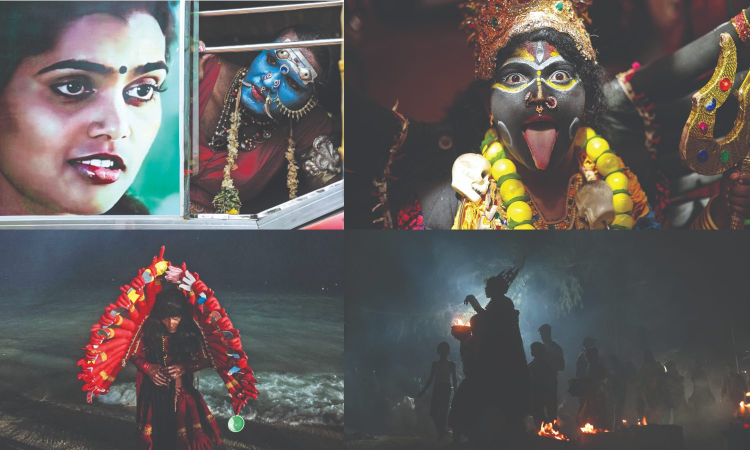Kulasai Dasara: The raw spectacle of faith
Jubilant processions, daring disguises, unflinching beliefs and hearts full of prayers paint Kulasekarapattinam in all hues

Visuals from Kulasai Dasara procession (Photos: Hemanathan M)
KULASEKARAPATTINAM: Covered in striking hues of blue, red, and black, adorned with skulls as jewellery, and holding blood-dripping swords and tridents in one of their dozens of arms, the men, women, and children have seemingly surrendered themselves to a sense of devotion that borders on trance.
This, clearly, is not your typical festival. The images that the camera captures are not the typical resplendent but sanitised calendar art that adorns homes. At Kulasai Dasara, the annual festival of the 300-year-old Arulmigu Sri Mutharamman temple in Kulasekarapattinam, the mood is raw and visceral, radiating with faith in its purest form – surrender.
This year, the celebrations began on September 23 and culminated in the dramatic Soorasamharam, re-enacting the Goddess’s triumph over demon Mahishasura, on October 2.
Unlike conventional Navratri festivities, Kulasai Dasara is a visual spectacle of faith and disguise. Devotees take on striking avatars, most famously Goddess Kali, with faces painted in bold shades of blue, red, or black, crowned with skull garlands and wielding swords. Others arrive as demons, monkey gods, or even contemporary cartoon characters, blurring lines between myth and modern imagination.
“Dressed as Goddess Kali and with my face painted blue, I walked in the Kulasai Dasara procession this year, praying for my sister’s marriage to get fixed. My prayers have come true each year thanks to the blessings of Goddess Mutharamman,” says Jeyaprakasham, a devotee at the grand folk spectacle that transforms the quiet coastal village of Kulasekarapattinam in Thoothukudi into a carnival of faith and colour.
Thousands of devotees like him throng the 300-year-old seaside temple for the Dasara festival (known as Kulasai Dasara), which is held annually in the Tamil month of Purattasi. They fulfil pledges made to the Goddess and observe rituals and spiritual austerities, including donning disguises.
One can’t choose the disguise on his own. “Our village has a saamiyadi (spiritual mediator) who enters a trance to decide what form each devotee must take,” explains Sithirai Kumar from Sirunadarkudieruppu, the village credited with starting the Dasara 'sets'. Fierce disguises like that of Thadagai, a horned demon draped in skulls, remain among the most dramatic sights.
At the temple, which is just steps away from the sea, Goddess Mutharamman is adorned with jewellery and costumes, and carried in majestic vahanams (spiritual vehicles) through jubilant processions.
Devotees follow a ritualistic journey: They first visit villages like Sirunadarkudieruppu, Kottankadu, Periyapuram, and Thandavankadu, which have the largest number of Dasara sets, before arriving at Kulasekarapattinam. On the final day, they immerse their disguises in the sea as offerings to the Goddess.
In a symbolic act of humility, devotees in disguise also beg alms from villagers and pilgrims, surrendering the collected offerings to Mutharamman on the tenth day. The practice, rooted in the belief of shedding ego and embracing equality, is central to the festival’s spirit.



